Effective Solutions to Prevent Cat Urination on Carpet


Intro
Inappropriate urination by cats can be perplexing and distressing for pet owners. This behavior often poses challenges not just in maintaining a clean home, but also in understanding a cat's emotional and physical needs. This guide aims to dissect the intricate issues surrounding feline urination on carpets, its implications, and feasible solutions for resolving this behavior effectively.
Pet Care and Grooming
Importance of Regular Care
Consistent care of your cat is essential, as it helps you monitor their health and well-being. Regularly checking your cat's litter box habits can alert you to changes in urination that might require attention. Cats often choose carpets for elimination due to their texture and scent. By ensuring your cat is healthy, you reduce the chance of them picking inappropriate locations.
Grooming Techniques by Pet Type
While grooming is typically not directly related to urination issues, maintaining clean fur can play a role in overall hygiene. Long-haired breeds may require more frequent brushing. Also, check if any underlying skin conditions might influence your cat's behavior. A clean environment can contribute to a feeling of comfort for your feline.
Tools and Products Recommendations
Using appropriate pet care products can aid in maintaining a clean space. Opt for enzymatic cleaners, which effectively eliminate odors that may attract a cat to re-mark territory. You may also consider using a high-quality litter that is comfortable for your cat and encourages proper usage.
Here are some recommended products:
- Nature's Miracle Stain & Odor Remover
- PetFusion Ultimate Cat Litter Box
- Arm & Hammer Cat Litter
Seasonal Care Tips
Seasons can affect a cat's behavior. In colder months, a reluctance to go outside may result in indoor accidents. Ensure that litter boxes are placed in accessible, quiet spaces, particularly as litter habits can change with environmental variations. Keeping your home comfortable, with manageable temperatures, will support your cat's overall happiness and health.
Health and Nutrition
Understanding Pet Nutrition
A balanced diet is crucial for maintaining your cat's health. Poor nutrition can contribute to urinary problems, making it vital to feed high-quality, species-appropriate food. Discuss dietary needs with your veterinarian to avoid health issues that could result in inappropriate urination.
Common Health Issues by Species
Felines can experience various health problems, such as urinary tract infections or bladder stones. These conditions often cause discomfort, which may lead to behavioral changes, including inappropriate urination. Regular check-ups are critical to addressing such issues promptly.
Preventive Care and Regular Check-Ups
Routine veterinary visits can help identify health problems before they become serious. Owners should watch for any changes in urination frequency, which can signal underlying health concerns. Early detection can stabilize your cat’s well-being and prevent the development of inappropriate elimination habits.
Behavioral Training
Basics of Positive Reinforcement
Understanding cat behavior is an essential step in addressing inappropriate urination. Positive reinforcement rewards desired behavior, helping to create a connection between appropriate litter box use and rewards such as treats or praise.
Training Techniques Users Can Apply
If a cat pees outside the litter box, return them to it immediately after, without punishment. Setting a routine encourages consistency, which is key in training. This can include scheduled litter box checks or reinforcing the use of the litter box after meals and after sleeping.
Managing Behavioral Issues
Sometimes, stress or anxiety is the root cause of inappropriate urination. If changes occur in your cat's environment, consider implementing stress-reduction techniques, such as maintaining a stable routine and providing hideaways.
Importance of Socialization
Socialization is vital in fostering a comfortable environment for your cat. Regular interaction with people and other pets can significantly reduce anxiety, an often overlooked cause of behavioral problems. Facilitating safe social interactions can help alleviate stress.
Engaging Activities and Enrichment
Fun Games to Play with Your Pet
Interactive play can enhance your cat's physical and mental well-being. Engaging with your cat through games like feather wands or laser pointers can effectively redirect their focus, minimizing stress behaviors, including inappropriate urination.
DIY Toys and Activities
Creating simple, homemade toys can provide lasting engagement for your cat. For instance, crumpled paper balls or hiding treats in boxes promotes activity and mental stimulation. Encourage exploration and problem-solving through play, as it may reduce anxiety-related behaviors.
Importance of Mental Stimulation
Cats need mental challenges just as much as physical exercise. Puzzles that dispense treats and climbing towers can provide stimulation. The more engaged your cat is, the less likely they are to exhibit unwanted behaviors inside the home.
Outdoor Adventures and Exploration
Outdoor activities can also enrich a cat's life. If your cat is comfortable outdoors, consider supervised walks with a harness. New sights and smells can provide stimulation and satisfaction, reducing the likelihood of stress-induced behaviors at home.
Resources and Community Engagement
Recommended Books and Websites
Increasing your knowledge on cat behavior is beneficial. Books like Cat Behavior Answer Book and websites like Wikipedia, Britannica provide valuable insights.
Forums and Groups for Pet Owners
Engaging with communities such as Reddit can offer practical advice from fellow cat owners facing similar challenges. Sharing experiences also creates a support network.
Finding Local Services and Classes
Look for local pet behaviorists or training programs that can provide tailored guidance. Participating in classes can help not only your cat but also refine your skills as an owner.
Encouraging Community Sharing and Contributions
Sharing success stories or strategies within online forums and community groups promotes a shared understanding of feline behavior. Collective knowledge can empower owners to find effective solutions collaboratively.
Addressing the issue of your cat peeing on the carpet requires a multifaceted approach. Protecting your home and enhancing the well-being of your feline is achievable with understanding and practical strategies.
Understanding the Problem
Understanding the reasons behind a cat's inappropriate urination is the first step in addressing this issue effectively. This section offers essential insights into the underlying factors that lead to this behavior. Recognizing these aspects helps cat owners implement appropriate solutions. Furthermore, awareness of possible medical, behavioral, territorial, and stress-related causes can guide owners toward making informed decisions.
Why Do Cats Pee Outside the Litter Box?
Cats may urinate outside their litter boxes for several reasons. They could be facing medical issues such as infections or bladder stones. Alternatively, environmental factors or a shift in behavior can contribute. Understanding these actions can prevent escalation and maintain a healthier relationship between pets and their owners.
Common Causes of Inappropriate Urination
Medical Issues
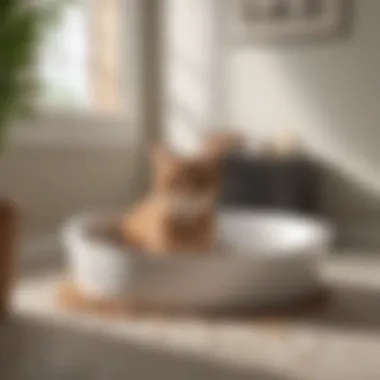

Medical problems are significant contributors to inappropriate urination. A cat suffering from a urinary tract infection might associate the litter box with pain. This discomfort can lead them to seek alternative locations, such as a cozy carpet. Recognizing this aspect is crucial in addressing urination issues. Immediate veterinary attention can be integral in identifying and treating any underlying health concern.
Behavioral Problems
Behavioral problems can arise from many factors, including fear or anxiety. These issues might develop due to changes in the household, like new pets or moving to a different home. Cats often react to their environment. Understanding behavioral patterns is key in this area. It allows owners to adapt their cat's surroundings to reduce anxiety and encourage proper bathroom habits.
Territorial Marking
Cats are naturally territorial animals. They may urinate to establish dominance or to mark their territory. This behavior is common when there are new pets in the house or when a change occurs within their environment. Recognizing territorial marking as a cause helps owners see it not purely as a nuisance, but as natural animal behavior. Appropriate strategies like providing individual spaces can mitigate conflicts and discourage such actions.
Stress Factors
Stress is another pivotal factor contributing to inappropriate urination. Various situations can trigger stress in cats, from loud noises to changes in routine. Creating a calm environment is beneficial for a cat's mental well-being. Stress management techniques, such as gentle interaction and maintaining a consistent daily schedule, can improve a cat’s comfort level and reduce accidents.
Understanding the reasons behind inappropriate urination allows pet owners to take a proactive approach, leading to a more harmonious living space.
Identifying the Triggers
Identifying the triggers behind a cat's inappropriate urination is essential for pet owners looking to mitigate this problematic behavior. Recognizing the specific elements that lead to accidents can help in developing effective strategies to prevent them. This process involves careful observation and a clear understanding of underlying factors that can cause your cat to pee outside the litter box.
It's important to remember that cats are creatures of habit. When routines change, cats may feel anxious or uncertain. This anxiety can manifest in various forms, including inappropriate urination. By pinpointing the specific triggers, owners can create a more stable environment and address the issues with appropriate actions. Understanding triggers not only aids in correcting the behavior but also strengthens the bond between the cat and its owner.
Observing Behavioral Patterns
Observing behavioral patterns is a critical part of identifying what may cause your cat to urinate on the carpet. Pay attention to when accidents occur. Is there a consistent time or situation that prompts this behavior? Keeping a journal may help in tracking these instances. Cats often communicate their discomfort or stress through behavior. Notice if they seem anxious or agitated before they urinate inappropriately. Analyzing these behaviors can reveal significant insights into the underlying issues.
Feline behavior is complex. Some cats may exhibit changes in pattern when exposed to different circumstances. In such cases, a swift response can nodoubt prevent further incidents.
Specific Situations Leading to Accidents
Changes in Household Routine
Changes in household routine can greatly impact a cat’s behavior. This aspect is crucial in understanding why your cat might choose the carpet over its litter box. Cats thrive on predictability. When their daily routine shifts, such as changes in feeding times or human schedules, it can lead to confusion and frustration for them. This can result in inappropriate urination.
A key characteristic of changes in routine is that they are often unavoidable. However, when monitored carefully, they can be managed. A unique feature of this aspect is its potential impact on a cat's mental health. Cats may begin to associate the litter box with stress rather than a safe space. That is where the disadvantage lies. Owners can benefit from maintaining as much consistency as possible in their cats' environment.
Preface of New Pets
Introducing new pets into a household may also trigger inappropriate urination. This scenario often creates competition for resources such as food, attention, and space. A dominant reaction may lead to stress in the existing cat, which can result in behavioral changes, including urination outside the litter box.
The key characteristic of this situation is the social dynamic it creates. For the existing cat, the introduction can be seen as a threat. This is particularly relevant for cats that already have established territories. The unique feature is that while introducing new pets can enrich the household, it can also lead to conflict. The advantage here is that, with time and proper management, cats can adjust to new companions and restore their previous habits.
Environmental Changes
Environmental changes encompass a broad range of factors. New furniture, renovation work, or changes in the household layout can all affect a cat's behavior. These changes can disrupt their familiar territory, leading to stress and a subsequent increase in inappropriate urination.
The key characteristic of environmental changes is that they can be both intentional and unintentional. For instance, moving furniture might create a new obstacle for the cat, confusing it about where it feels secure and safe. The unique feature of this aspect of cat behavior is that it often requires patience and gradual adjustment from both the pets and their owners. Adapting the environment thoughtfully can reduce stress levels, thus lessening the likelihood of accidents on the carpet.
Understanding these triggers is essential for combating the issue of inappropriate urination. It enables cat owners to make informed changes to both the environment and routines in order to support their pets' wellbeing.
Assessing Health Concerns
Assessing health concerns is vital when tackling the issue of inappropriate urination in cats. Understanding that underlying health issues may lead to this behavior can significantly enhance the chances of successful intervention. By identifying medical problems early, cat owners can not only improve their pets' health but also reduce stress in both the animal and the household.
A proactive approach to health assessments ensures that potential medical conditions are addressed before they escalate. This can also prevent further complications, save costs on treatments, and ultimately build a stronger bond between the owner and the cat, knowing the pet is healthy and happy.
Consulting a Veterinarian
Consulting a veterinarian is the first step in assessing health concerns. An experienced vet can perform a thorough check-up to ascertain if any medical issues exist. During the visit, it is crucial for owners to share specific observations, such as changes in urination behavior, frequency, and any other symptoms like lethargy or changes in appetite.
A veterinarian can use diagnostic tests, such as blood work and urinalysis, to discover potential problems. Early detection of issues can lead to more effective treatment plans and recovery.
Common Feline Health Problems
Certain health problems are particularly common in cats that may lead to inappropriate urination. Here, we explore three prevalent ones:
Urinary Tract Infections
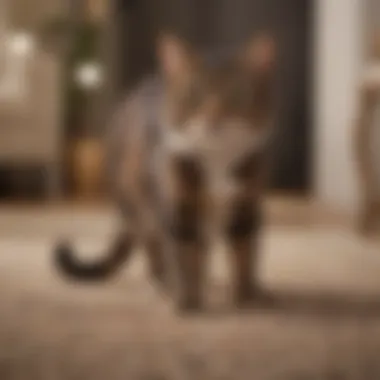
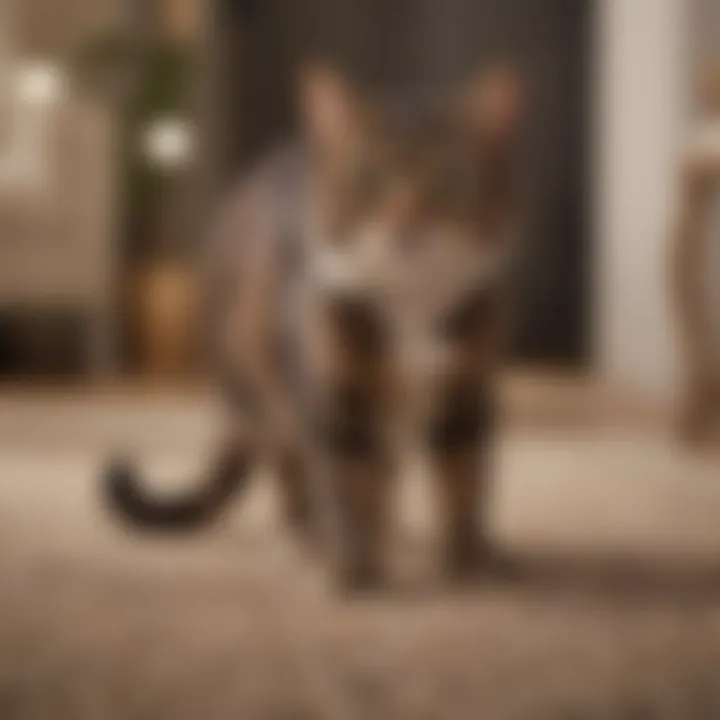
Urinary Tract Infections (UTIs) can be a significant contributor to inappropriate urination. Cats suffering from UTIs often show signs of discomfort, frequent urination, or strain while trying to urinate.
A key characteristic of UTIs is that they can lead to actual pain during urination, making the litter box a less appealing option. For this reason, understanding UTIs is beneficial for this article, as it helps owners identify and recognize symptoms early. Moreover, appropriate treatment can resolve this issue quickly, restoring normal behavior for the cat.
Kidney Disease
Kidney Disease is another medical condition to consider. This disease often develops slowly and can lead to increased thirst and urination.
One striking feature of Kidney Disease is that it may remain unnoticed until it progresses to a severe stage. This aspect makes it especially important to have regular veterinary check-ups, as identification can greatly help in managing the health of the cat. Early intervention can lead to better quality of life and behavior management.
Diabetes
Diabetes in cats is an important health consideration, as it can also lead to an increase in urination and thirst. Cats with diabetes may urinate more frequently because their bodies are unable to absorb glucose into the cells, leading to excess sugar in the urine.
The unique feature of diabetes lies in its manageable nature. With proper veterinary care, dietary changes, and insulin therapy, cats can often lead healthy lives. This makes raising awareness about diabetes essential in discussing inappropriate urination, as timely diagnosis can improve the cat's health significantly.
Regular vet check-ups can help prevent serious health problems and maintain your cat's well-being.
Overall, understanding health concerns is fundamental to resolving issues surrounding inappropriate urination. By addressing these common feline health problems with targeted veterinary care, cat owners can contribute positively to the livability of their homes and the welfare of their pets.
Environmental Adjustments
Understanding how to stop your cat from urinating on the carpet requires an examination of environmental factors. Environmental adjustments play a crucial role in addressing inappropriate urination. This means creating a comfortable, suitable, and appealing atmosphere for your feline friend. It enables you to alleviate stressors that may lead to accidents and ensures that the litter box becomes a preferred area for your cat’s needs.
Improving Litter Box Appeal
Choosing the Right Litter
Choosing the right litter is not a trivial decision; it significantly impacts whether your cat will use the litter box consistently. Cats are known for their selective nature, and they often prefer certain types of litter. A key characteristic of effective litter is its texture. Many cats favor fine-grain litter that mimics natural soil. This makes clumping clay litters a popular choice among pet owners.
A unique feature of clumping litters is that they absorb moisture and form solid clumps upon urination. This promotes easy cleanup and allows you to maintain cleanliness in the box. However, it is important to consider that some cats might dislike the scent of certain scented litters, causing them to avoid the box altogether. Therefore, testing different options to find the right fit for your cat is crucial.
Optimal Box Placement
Optimal box placement is another aspect that can greatly influence your cat's litter box usage. Cats require privacy while attending to their needs. Therefore, placing the litter box in a quiet, low-traffic area is essential. A key point to remember is that accessibility matters; an easily reachable location encourages regular visits to the box.
Choose locations where your cat feels secure. An appropriate area might be a room that offers seclusion but is also monitored by you. A unique feature of strategic box placement is that it can minimize the likelihood of accidents caused by stress or anxiety. On the downside, if the box is out of sight and not easily accessible, your cat may not use it.
Creating a Stress-Free Environment
Safe Spaces for Cats
A critical element in fostering a stress-free environment for cats is the establishment of safe spaces. These areas should provide a retreat where your cat can feel secure. A safe space is typically enclosed, perhaps a cozy bed placed in a quiet corner. Cats need places where they can escape from perceived threats or noise.
The key characteristic of a safe space is that it reduces anxiety. Providing areas that allow your cat to retreat can greatly decrease their urge to mark territory by urination. However, it’s essential to remain mindful that the safe space should not become a hiding spot for long periods, as this may indicate deeper issues requiring attention.
Utilizing Feliway Products
Feliway products offer a synthetic pheromone solution to help calm stressed cats. These products mimic natural feline facial pheromones, promoting a sense of tranquility. The key characteristic of Feliway is its ability to reduce stress-related behaviors, including inappropriate urination.
The unique feature of Feliway is its versatility. It comes in both sprays and diffusers, making it easy to integrate into your home. However, while many cat owners find relief using these products, results can vary. Some cats may not respond to these pheromones, thus limiting their effectiveness for every situation. Overall, integrating Feliway into your home can be a beneficial step if your cat exhibits stress or anxiety.
Remember, creating an environment that encourages comfort and security is fundamental to helping your cat stop peeing on the carpet.
Behavioral Modifications
Behavioral modifications are crucial for addressing the issue of cats urinating on carpets. Understanding the behaviors of your cat is essential. Cats do not engage in this behavior without reason. Recognizing their underlying motivations can guide owners in correcting the issue effectively. This section focuses on practical modifications that improve both cat and owner's experiences.
Changing a cat's behavior takes time and patience. Owners need to approach the situation thoughtfully. Behavioral modifications rely on consistency and positive experiences. Effective interventions consider the cat's perspective and offer a humane way to influence change.
Before implementing any modifications, it is necessary to understand that these efforts are not just about punishment. Instead, they emphasize building a trustful relationship and enhancing well-being within the cat's environment.
Positive Reinforcement Techniques
Positive reinforcement is an effective way to train a cat. Instead of scolding when an accident occurs, encourage the desired behavior with rewards. When your cat uses the litter box correctly, offer praise, treats, or playtime. This method shows the cat that appropriate behavior leads to positive outcomes.
Here are some tips for positive reinforcement:
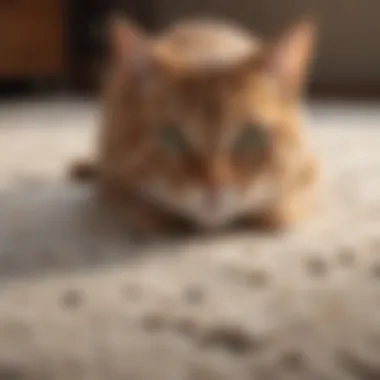
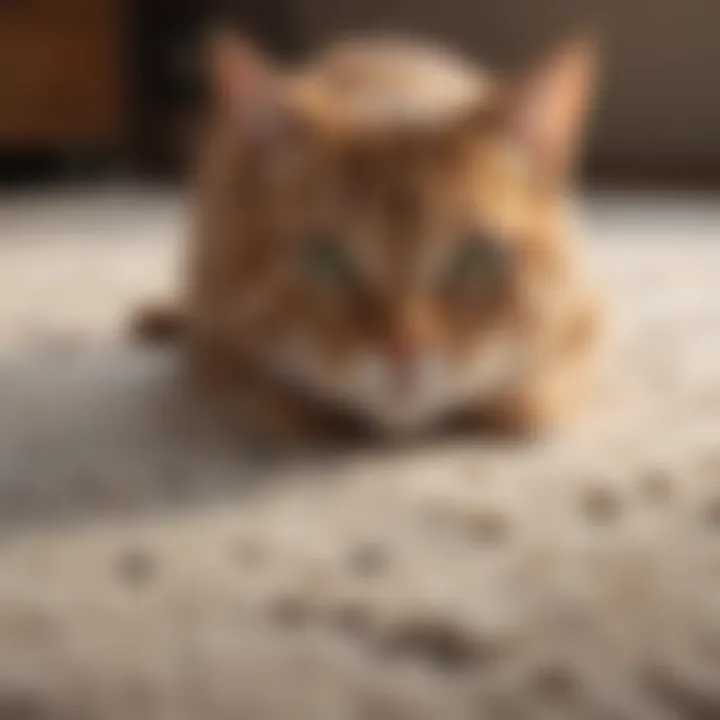
- Be Immediate: Reward the cat right after they use the litter box.
- Use High-Value Treats: Offer special treats only for this purpose. This creates a stronger connection.
- Create a Routine: Cats thrive on routine; consistency helps them understand when and where they should go.
Positive reinforcement can transform a negative pattern into positive experiences. Over time, the cat learns to associate the litter box with rewards, reducing the likelihood of accidents.
Consistency is Key
Consistency is an essential element in modifying a cat's behavior. Without a predictable routine, a cat can feel confused and anxious, which might exacerbate urination issues. Owners should establish a regular schedule for litter box cleaning, feeding, and playtime to help their cat feel secure.
Consider the following practices:
- Establish and Stick to a Routine: Cats respond well to regular habits. Feeding and playtimes should be at the same intervals each day.
- Maintain Litter Box Hygiene: Clean the litter box daily. Cats are more likely to use a clean environment.
- Reinforcement Consistency: Always use the same system for positive reinforcement. Inconsistency can cause confusion for the cat.
These small adjustments create a predictable atmosphere for your cat. The less stress the cat feels, the less likely it is to seek alternative urination spots.
Cleaning and Odor Control
Cleaning and odor control is very important when dealing with cat urination issues. If you do not clean properly, your cat can continue peeing in the same spot, thinking it's allright. This behavior can create a loop of issues, making it hard for you to change this habit.
Cleaning removes not only the visible stains but also the scent markers that signal to your cat that this spot is acceptable for elimination. Achieving a thorough clean can prevent future incidents. Moreover, odors that linger in your home can also invite more problems, such as attracting other pets or creating an uncomfortable environment.
The right cleaning methods and products can assist significantly in making your home smell fresh. Let's delve into effective cleaning solutions and preventive measures.
Effective Cleaning Solutions
To clean effectively, it’s critical to choose the right products. Some cleaners do not break down the compounds in cat urine as well as others do, causing persistent odors. Look for solutions labeled as safe for pets and effective against urine.
When cleaning, it’s necessary to:
- Blot the area first rather than rubbing to prevent spreading.
- Use cold water. Warm water can set stains.
- Rinse area afterward if using a cleaning solution, to remove residues.
By using the right approach, you can eliminate both stains and smells, which helps in changing your cat’s behavior.
Preventing Future Incidents
Once you clean the area, the goal is to prevent similar accidents in the future. Education about retraining your cat and using proper cleaning supplies will empower you.
Using Enzyme Cleaners
Using enzyme cleaners can be effective for tackling cat urine odors. These cleaners contain specific bacteria and enzymes that break down urine into harmless substances. This characteristic makes them a popular choice among pet owners.
One unique feature is their ability to eliminate not just the stain but the smell. This is crucial. If any trace of odor remains, your cat may feel encouraged to use the same spot again. However, a downside is that these cleaners often require some time to work effectively.
Re-Training and Prevention
Re-training your cat is crucial after dealing with accidents. This process strengthens litter box habits. It means observing your cat closely and rewarding them when they use the box correctly. It integrates positive behaviors that lead to permanent changes.
The main appeal of re-training is its proactive nature. You’re not only cleaning but also modifying behavior. This approach lays the foundation for further success and can turn a challenging situation into a learning opportunity both for you and your pet. Though sometimes tedious, persistence often yields positive results.
When All Else Fails
At times, despite your best efforts, your cat may still urinate outside the litter box. This section addresses what to do when all other strategies do not solve the problem. Recognizing that every cat is unique, sometimes the solutions are not immediately evident. By seeking support, you can gain insights that are tailored to your specific situation.
This phase emphasizes the importance of intervention. If you notice persistent inappropriate urination, it can be an indication of deeper issues. Ignoring this can lead to further complications in both your cat's health and your relationship with them.
Seeking Professional Help
When self-directed efforts have not succeeded, it is prudent to seek professional help. A veterinarian can run diagnostics to rule out medical conditions that may contribute to inappropriate urination. Common health issues such as urinary tract infections or kidney dysfunction could require immediate treatment.
It is crucial to communicate openly with the veterinarian about your observations regarding your cat's behavior. This dialogue aids in establishing a comprehensive understanding of your cat’s needs. Regular veterinary check-ups are also beneficial. If illness is not the root cause, they can recommend behavioral specialists. This ensures a holistic approach to your cat's well-being.
Behavioral Specialists and Trainers
In some cases, the assistance of behavioral specialists or trainers may be necessary. These professionals focus on understanding animal behavior and can devise strategies to address inappropriate urination. They evaluate your cat’s environment and suggest modifications or training techniques that align with your cat's personality.
Benefits of consulting specialists include:
- Customized behavior plans.
- Expert guidance on training techniques.
- Identification of any stressors in the environment that may not be obvious to owners.
If you are considering this route, ensure you choose a qualified professional. Look for those with experience in feline behavior. They may offer insights into techniques like cat-friendly training methods or stress reduction strategies. These interventions could ultimately lead to a more harmonious home for both you and your pet.
Professional guidance can provide valuable options that might not be evident through personal efforts alone.
In summary, if you reach this stage, it indicates a need for a more structured and informed approach. Professionally addressing the issue can help restore balance in your home and significantly reduce stress for both you and your cat.















